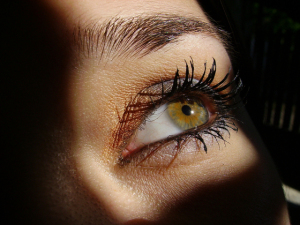Eye Movement Exam More Accurate Than MRI in Stroke Prediction
by
Brendon Nafziger, DOTmed News Associate Editor | September 29, 2009

The eyes have it
when it comes to
stroke detection
A simple bedside eye movement exam is more accurate than MRI in predicting certain kinds of strokes, according to an article in the journal Stroke published online and ahead-of-print last week.
The three-part eye exam was able to identify all patients in the study who had a stroke to the back part of the brain, whereas an MRI conducted in the first day or two after hospital admission missed more than one in ten strokes.
Just dizzy?
Around 20 percent of strokes attack the back part of the brain. Unlike strokes to the front part of the brain, patients with back-brain strokes often do not show the common symptoms of stroke, such as numbness or paralysis to one side of the body. Instead, these patients often come to the emergency room complaining of severe dizziness, usually accompanied by nausea, vomiting and an unsteady gait. The problem is that this syndrome, known as acute vestibular syndrome (AVS), could also indicate a much less serious medical condition involving the inner ear.
"When someone comes in with AVS, it's usually one of two things--a benign inner ear condition, or a dangerous stroke in the back part of the brain -- in the brainstem or cerebellum. Differentiating between the two is challenging," David Newman-Toker, M.D., Ph.D., professor of neurology at Johns Hopkins Hospital and lead author of the study, tells DOTmed News.
Often a diagnosis of stroke is thought to be ruled out by a normal early MRI scan performed in the first 24 to 48 hours after symptom onset. But Dr. Newman-Toker says the medical literature predicts up to 23 percent of strokes in the back part of the brain can be missed with early MRIs. And misdiagnoses for strokes are critical, as those with lower-brain strokes generally have good outcomes if treated in time. But if not, "up to 40 percent of patients who have a stroke and get missed have a serious adverse outcome that results in permanent disability or death," Dr. Newman-Toker says.
Dr. Newman-Toker and his team studied 101 patients admitted to an emergency room (or transferred there from another department) with AVS and at least one risk factor for stroke -- such as diabetes or high blood pressure. These patients were given the eye exam, then an early MRI, and then an MRI much later to confirm the diagnosis. (MRIs taken a significant time after the stroke, when damage is more visible, are still the "gold standard" for stroke diagnosis, short of autopsy, Dr. Newman-Toker says.)
Of these patients, 69 were confirmed by the later MRI to have had strokes, and all were identified by the eye exam. But the early MRI missed 12 percent of these patients with strokes. The eye exam was highly accurate, only giving false positives for stroke in one out of the 25 patients who really had an inner ear condition.
